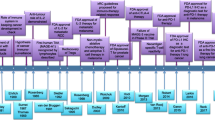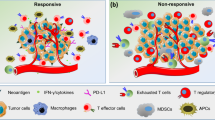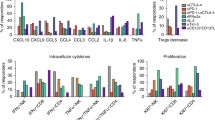Abstract
The immune system plays an essential role in the surveillance and eradication of neoplastic cells. This interaction is modulated via immunologic regulators (checkpoints). Antibodies that block the checkpoints cytotoxic T lymphocyte-associated antigen 4 (CTLA-4), and the programmed cell death protein 1 pathway (PD1/PD-L1) have demonstrated efficacy in a number of malignancies. However, response rates are variable, and administration of these antibodies can be associated with immune-related adverse events. Therefore, researchers are engaged in an effort to discover biomarkers that may predict response to these agents. This review focuses on potential blood and tumor-based biomarkers that have been assessed in patients treated with these checkpoint-blocking antibodies.
Similar content being viewed by others
References
Papers of particular interest, published recently, have been highlighted as: •• Of major importance
Robert C et al. Nivolumab in previously untreated melanoma without BRAF mutation. N Engl J Med. 2015;372(4):320–30.
Robert C et al. Anti-programmed-death-receptor-1 treatment with pembrolizumab in ipilimumab-refractory advanced melanoma: a randomised dose-comparison cohort of a phase 1 trial. Lancet. 2014;384(9948):1109–17.
Robert C et al. Ipilimumab plus dacarbazine for previously untreated metastatic melanoma. N Engl J Med. 2011;364(26):2517–26.
Wolchok JD et al. Ipilimumab monotherapy in patients with pretreated advanced melanoma: a randomised, double-blind, multicentre, phase 2, dose-ranging study. Lancet Oncol. 2010;11(2):155–64.
Garon EB et al. Pembrolizumab for the treatment of non-small-cell lung cancer. N Engl J Med. 2015;372(21):2018–28.
Gettinger SN et al. Overall survival and long-term safety of nivolumab (anti-programmed death 1 antibody, BMS-936558, ONO-4538) in patients with previously treated advanced non-small-cell lung cancer. J Clin Oncol. 2015;33(18):2004–12.
Motzer RJ et al. Nivolumab for metastatic renal cell carcinoma: results of a randomized phase II trial. J Clin Oncol. 2015;33(13):1430–7.
Le DT et al. PD-1 blockade in tumors with mismatch repair deficiency. ASCO Meet Abstr. 2015;33(15_suppl):LBA100.
Templeton AJ, Templeton AJ, et al. Prognostic role of neutrophil-to-lymphocyte ratio in solid tumors: a systematic review and meta-analysis. J Natl Cancer Inst. 2014;106(6):dju124.
Zaragoza J, et al. Neutrophil to lymphocyte ratio measured before starting ipilimumab treatment is associated with reduced overall survival in patients with melanoma. Br J Dermatol. 2015.
Ferrucci PF et al. Baseline neutrophil-to-lymphocyte ratio is associated with outcome of ipilimumab-treated metastatic melanoma patients. Br J Cancer. 2015;112(12):1904–10.
Simeone E et al. Immunological and biological changes during ipilimumab treatment and their potential correlation with clinical response and survival in patients with advanced melanoma. Cancer Immunol Immunother. 2014;63(7):675–83.
Ku GY et al. Single-institution experience with ipilimumab in advanced melanoma patients in the compassionate use setting. Cancer. 2010;116(7):1767–75.
Postow MA, et al. Pharmacodynamic effect of ipilimumab on absolute lymphocyte count (ALC) and association with overall survival in patients with advanced melanoma. ASCO Meeting Abstracts, 2013. 31(15_suppl):9052.
Johnson DB, Peng C, Sosman JA. Nivolumab in melanoma: latest evidence and clinical potential. Ther Adv Med Oncol. 2015;7(2):97–106.
Callahan MK et al. Peripheral and tumor immune correlates in patients with advanced melanoma treated with combination nivolumab (anti-PD-1, BMS-936558, ONO-4538) and ipilimumab. ASCO Meet Abstr. 2013;31(15_suppl):3003.
Gaba L et al. Changes in blood eosinophilia during anti-PD1 therapy as a predictor of long term disease control in metastatic melanoma. ASCO Meet Abstr. 2015;33(15_suppl):9069.
Kim DW et al. Predictive markers for programmed death-1 (PD-1)/programmed death-ligand 1 (PD-L1) axis blockade therapy in patients with metastatic melanoma (MM). ASCO Meet Abstr. 2015;33(15_suppl):e20029.
Valpione S et al. Personalised medicine: development and external validation of a prognostic model for metastatic melanoma patients treated with ipilimumab. Eur J Cancer. 2015;51(14):2086–94.
Gnjatic S et al. NY‐ESO‐1: review of an immunogenic tumor antigen. In: Advances in Cancer Research. Academic Press; 2006. p. 1–30.
Yuan J et al. CTLA-4 blockade enhances polyfunctional NY-ESO-1 specific T cell responses in metastatic melanoma patients with clinical benefit. Proc Natl Acad Sci U S A. 2008;105(51):20410–5.
Yuan J et al. Integrated NY-ESO-1 antibody and CD8+ T-cell responses correlate with clinical benefit in advanced melanoma patients treated with ipilimumab. Proc Natl Acad Sci U S A. 2011;108(40):16723–8.
Goff SLMD et al. No correlation between clinical response to CTLA-4 blockade and presence of NY-ESO-1 antibody in patients with metastatic melanoma. J Immunother. 2009;32(8):884–5.
Weide B et al. Functional T cells targeting NY-ESO-1 or Melan-a Are predictive for survival of patients with distant melanoma metastasis. J Clin Oncol. 2012;30(15):1835–41.
Hutloff A et al. ICOS is an inducible T-cell co-stimulator structurally and functionally related to CD28. Nature. 1999;397(6716):263–6.
Liakou CI et al. CTLA-4 blockade increases IFNγ-producing CD4 + ICOShi cells to shift the ratio of effector to regulatory T cells in cancer patients. Proc Natl Acad Sci U S A. 2008;105(39):14987–92.
Carthon BC et al. Preoperative CTLA-4 blockade: tolerability and immune monitoring in the setting of a Presurgical clinical trial. Clin Cancer Res. 2010;16(10):2861–71.
Ng Tang D et al. Increased frequency of ICOS+ CD4 T cells as a pharmacodynamic biomarker for anti-CTLA-4 therapy. Cancer Immunol Res. 2013;1(4):229–34.
Postow M et al. Peripheral and tumor immune correlates in patients with advanced melanoma treated with nivolumab (anti-PD-1, BMS-936558, ONO-4538) monotherapy or in combination with ipilimumab. J Transl Med. 2014;12 Suppl 1:O8.
Robert L et al. CTLA4 blockade broadens the peripheral T-cell receptor repertoire. Clin Cancer Res. 2014;20(9):2424–32.
Cha E et al. Improved survival with T cell clonotype stability after anti-CTLA-4 treatment in cancer patients. Sci Transl Med. 2014;6(238):238ra70.
Postow MA et al. Peripheral T cell receptor diversity is associated with clinical outcomes following ipilimumab treatment in metastatic melanoma. J Immunother Cancer. 2015;3:23.
Gabrilovich DI, Nagaraj S. Myeloid-derived suppressor cells as regulators of the immune system. Nat Rev Immunol. 2009;9(3):162–74.
Gabrilovich DI, Ostrand-Rosenberg S, Bronte V. Coordinated regulation of myeloid cells by tumours. Nat Rev Immunol. 2012;12(4):253–68.
Filipazzi P et al. Identification of a new subset of myeloid suppressor cells in peripheral blood of melanoma patients with modulation by a granulocyte-macrophage colony-stimulation factor-based antitumor vaccine. J Clin Oncol. 2007;25(18):2546–53.
Tarhini AA et al. Immune monitoring of the circulation and the tumor microenvironment in patients with regionally advanced melanoma receiving neoadjuvant ipilimumab. PLoS One. 2014;9(2):e87705.
Meyer C et al. Frequencies of circulating MDSC correlate with clinical outcome of melanoma patients treated with ipilimumab. Cancer Immunol Immunother. 2014;63(3):247–57.
Callahan M et al. Peripheral blood and tumor biomarkers in patients with advanced melanoma treated with combination nivolumab (anti-PD-1, BMS-936558, ONO-4538) and ipilimumab. J ImmunoTher Cancer. 2013;1 Suppl 1:O6.
Topalian SL et al. Safety, activity, and immune correlates of anti-PD-1 antibody in cancer. N Engl J Med. 2012;366(26):2443–54.
Grosso J et al. Association of tumor PD-L1 expression and immune biomarkers with clinical activity in patients (pts) with advanced solid tumors treated with nivolumab (anti-PD-1; BMS-936558; ONO-4538). ASCO Meet Abstr. 2013;31(15_suppl):3016.
Herbst RS et al. Predictive correlates of response to the anti-PD-L1 antibody MPDL3280A in cancer patients. Nature. 2014;515(7528):563–7. This was the first paper to examine the role of PD-1/PD-L1 as a potential biomarker of response to PD-1 blockade.
Postow MA et al. Nivolumab and ipilimumab versus ipilimumab in untreated melanoma. N Engl J Med. 2015;372(21):2006–17.
Wolchok JD et al. Nivolumab plus ipilimumab in advanced melanoma. N Engl J Med. 2013;369(2):122–33.
Larkin J, et al. Combined nivolumab and ipilimumab or monotherapy in untreated melanoma. N Engl J Med. 2015.
Madore J et al. PD-L1 expression in melanoma shows marked heterogeneity within and between patients: implications for anti-PD-1/PD-L1 clinical trials. Pigment Cell Melanoma Res. 2015;28(3):245–53.
Tumeh PC et al. PD-1 blockade induces responses by inhibiting adaptive immune resistance. Nature. 2014;515(7528):568–71. Tumeh and colleagues elegantly characterize the tumor immune microenvironment and relationship between tumor infiltrating lymphocytes and response to immunotherapy.
Ji RR et al. An immune-active tumor microenvironment favors clinical response to ipilimumab. Cancer Immunol Immunother. 2012;61(7):1019–31.
Hamid O et al. A prospective phase II trial exploring the association between tumor microenvironment biomarkers and clinical activity of ipilimumab in advanced melanoma. J Transl Med. 2011;9:204.
Ribas A et al. Association of response to programmed death receptor 1 (PD-1) blockade with pembrolizumab (MK-3475) with an interferon-inflammatory immune gene signature. ASCO Meet Abstr. 2015;33(15_suppl):3001.
Alexandrov LB et al. Signatures of mutational processes in human cancer. Nature. 2013;500(7463):415–21.
van Rooij N et al. Tumor exome analysis reveals neoantigen-specific T-cell reactivity in an ipilimumab-responsive melanoma. J Clin Oncol. 2013;31(32):e439–42.
Snyder A et al. Genetic basis for clinical response to CTLA-4 blockade in melanoma. N Engl J Med. 2014;371(23):2189–99. This is a seminal paper which establishes the role of mutational load in predicting response to immunotherapy, as well as the potential homology between neoepitopes and viral and bacterial antigens.
Rizvi NA et al. Cancer immunology. Mutational landscape determines sensitivity to PD-1 blockade in non-small cell lung cancer. Science. 2015;348(6230):124–8.
Weber JS et al. Safety, efficacy, and biomarkers of nivolumab with vaccine in ipilimumab-refractory or -naive melanoma. J Clin Oncol. 2013;31(34):4311–8.
Antonia SJ et al. P2.11-035 Association of tumor PD-L1 expression and immune biomarkers with clinical activity in patients treated with non-small cell lung cancer (NSCLC) treated with nivoluamb (Anti-PD-1; BMS-936558; ONO-4538). J Thorac Oncol. 2013;8:S1–S1410.
Daud AI. Antitumor activity of the anti-PD-1 monoclonal antibody MK-3475 in melanoma(MEL): correlation of tumor PD-L1 expression with outcome [abstract]. Proc. Ann. Meeting AACR, 2014: p. CT104.
Gandhi L. MK-3475 (anti-PD-1 monoclonal antibody) for non-small cell lung cancer (NSCLC): antitumor activity and association with tumor PD-L1 expression [abstract]. Proc. Ann. Meeting AACR, 2014: p. CT105.
Seiwert TY et al. A phase Ib study of MK-3475 in patients with human papillomavirus (HPV)-associated and non-HPV-associated head and neck (H/N) cancer. ASCO Meet Abstr. 2014;32(15_suppl):6011.
Ribas A et al. Efficacy and safety of the anti-PD-1 monoclonal antibody MK-3475 in 411 patients (pts) with melanoma (MEL). ASCO Meet Abstr. 2014;32(15_suppl):LBA9000.
Hamid O et al. Clinical activity, safety, and biomarkers of MPDL3280A, an engineered PD-L1 antibody in patients with locally advanced or metastatic melanoma (mM). ASCO Meet Abstr. 2013;31(15_suppl):9010.
Soria JC et al. Clinical activity, safety and biomarkers of PD-L1 blockade in non-small cell lung cancer (NSCLC): Additional analyses from a clinical study of the engineered antibody MPDL3280A (anti-PDL1). Eur J Cancer. 2013;49:S97–S153.
Powles T et al. MPDL3280A (anti-PD-L1) treatment leads to clinical activity in metastatic bladder cancer. Nature. 2014;515(7528):558–62.
Segal NH et al. Preliminary data from a multi-arm expansion study of MEDI4736, an anti-PD-L1 antibody. ASCO Meet Abstr. 2014;32(15_suppl):3002.
Rizvi NA et al. Safety and clinical activity of MEDI4736, an anti-programmed cell death-ligand 1 (PD-L1) antibody, in patients with non-small cell lung cancer (NSCLC). ASCO Meet Abstr. 2015;33(15_suppl):8032.
Segal NH et al. Safety and efficacy of MEDI4736, an anti-PD-L1 antibody, in patients from a squamous cell carcinoma of the head and neck (SCCHN) expansion cohort. ASCO Meet Abstr. 2015;33(15_suppl):3011.
Author information
Authors and Affiliations
Corresponding author
Ethics declarations
Conflict of Interest
Claire F. Friedman has received travel reimbursement from Bristol-Myers Squibb.
Michael A. Postow has received research funding through a grant from Bristol-Myers Squibb and has received honoraria from Merck, compensation from Caladrius, and Amgen for service on advisory boards, and honoraria and travel reimbursement from Bristol-Myers Squibb.
Human and Animal Rights and Informed Consent
This article does not contain any studies with human or animal subjects performed by any of the authors.
Additional information
This article is part of the Topical Collection on Melanoma
Rights and permissions
About this article
Cite this article
Friedman, C.F., Postow, M.A. Emerging Tissue and Blood-Based Biomarkers that may Predict Response to Immune Checkpoint Inhibition. Curr Oncol Rep 18, 21 (2016). https://doi.org/10.1007/s11912-016-0509-x
Published:
DOI: https://doi.org/10.1007/s11912-016-0509-x




